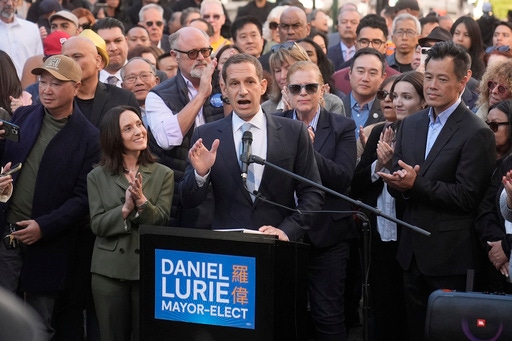New Leadership in San Francisco: Mayor Daniel Lurie’s Collaborative Approach
SAN FRANCISCO—In a city grappling with internal discord and significant challenges, Mayor Daniel Lurie emerges as a beacon of hope for San Francisco’s liberals. With a promise to restore effective governance, Lurie aims to tackle persistent urban issues that have defined the city’s recent past, such as open drug use, increased homelessness, and a struggling downtown.
A Fresh Face in City Hall
Defeating incumbent Mayor London Breed in a closely watched election, Lurie—an heir to the Levi Strauss fortune and founder of the Tipping Point Community nonprofit—invested nearly $10 million of his own funds into his campaign. His campaign resonated with voters who expressed a desire for accountability and progress, leading to a changing of the guard in November.
Engaging with the Community
Known for his approachable demeanor, Lurie frequently engages with city residents, including both housed and unhoused individuals, and actively seeks input from city supervisors. In marking his first 100 days in office, Lurie expressed a commitment to improving public safety and aligning city functions with community needs.
“I was elected to turn this city around,” Lurie emphasized. “And I want everybody in San Francisco to know that their mayor is focused on getting results for San Franciscans.”
Collaborative Governance
With hopes of reducing gridlock, some city officials have noted an encouraging shift in collaboration since Lurie’s takeover. Progressive Supervisor Connie Chan remarked on the enhanced communication she has experienced with Lurie compared to previous leadership.
Addressing Crime and Homelessness
Lurie’s strategy includes enhancing policing and expanding shelter and treatment options, building upon initiatives established during Breed’s administration. Notably, he aims to add 1,500 new shelter beds and is advancing legislation that accelerates behavioral health initiatives to combat the fentanyl crisis.
Public Drug Use Policy Changes
As part of a broader approach to public drug use, Lurie has introduced new regulatory measures concerning the distribution of drug paraphernalia. Nonprofits will now be required to offer treatment services prior to distributing items, reflecting a shift from past harm reduction strategies.
Balancing Corporate Influence and Advocacy
Lurie, who has deep connections within San Francisco’s business community, is assembling boards composed of tech executives and philanthropists, including figures from Google and OpenAI, to rejuvenate the city’s downtown image. While some express concern over corporate influence, others recognize his willingness to engage with diverse stakeholders.
“I want business to be here. I want those jobs here. I want that tax revenue here,” Lurie stated. “And I want them to be part of rebuilding San Francisco.”
Upcoming Challenges
As he navigates the complexities of city governance, Lurie faces significant fiscal challenges, including a projected $800 million budget gap over the next two years. His approach to funding cuts and prioritization will be closely scrutinized by city officials and residents alike.
Supervisor Jackie Fielder has already proposed a measure that would grant children a right to shelter, potentially conflicting with Lurie’s existing policies for homeless families. This upcoming debate could test the collaborative spirit that Lurie hopes to cultivate.
Conclusion
Mayor Daniel Lurie’s first steps in office reflect a commitment to collaboration and community-focused policies. Whether he can effectively balance the demands of diverse interests while addressing critical challenges will determine his legacy as San Francisco’s mayor.



